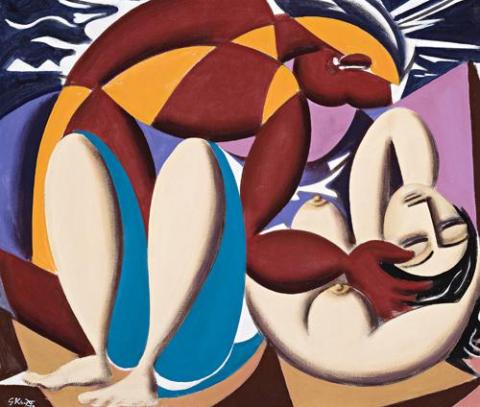SURYA AND PRITHA, 1973
George Keyt
oil on canvas
88.0 x 104.0 cm
signed and dated lower left: G KEYT/ 73
Private collection, Melbourne
Halpe, A., George Keyt, The George Keyt Felicitation Committee, Colombo, 1977, p.77 (illus.)
Combining the inspiring discipline and austerity of an Indian seer with the verve and sparkle of the European experimentalist, George Keyt is widely regarded as Sri Lanka's only truly universal artist- his art symbolising a synthesis of East and West that is unique both within the Hindu idiom and twentieth-century painting generally.
A Ceylonese of Indo-Dutch descent, Keyt embarked upon his career as an artist in 1927, a time when '...there was no longer any art which was both Sri Lankan and modern.'1 Rejecting the stifling values of the Victorian milieu in which he had been raised, he thus sought moral and spiritual refreshment in Kandyan rural culture, immersing himself in Buddhist thought and Sinhala poetry at the ancient hill capital, Malwatte Vihare. Importantly, it was this experience of Hindu and Sinhala iconography gleaned directly from the striking medieval temple frescoes and sculpture, together with his later appreciation of contemporary French painting through the illustrations featured in the art magazine Cahiers D'Art, that would exert the most enduring influence upon his highly stylised, sensuous compositions such as the present Surya and Pritha 1937.
From 1937-38, Keyt's predilection for poetry and romance subjects flourished, with paintings of lovers occupying much of his production. Yet unlike elsewhere in his oeuvre, such works do not portray human lives but rather, the pursuits and affections of the gods of Hindu mythology- for example here the celestial Pritha, wife of the mighty monarch King Pandu, is raped by Surya, the God of the Sun. Subsequently, Pritha secretly became the mother of his son, Karna whom, in her maidenly shame, she concealed in a wicker basket and set adrift on the Gange River. Employing the distinctly cubist formula of the oval face with sharp profile simultaneously rendered, as well as the movement's structural rendering of curvilinear forms and general distortion of the human figure, indeed Surya and Pritha illustrates well the artist's strong stylistic affinities with his European contemporaries- namely Braque, Picasso and Leger. In spirit however, Keyt's aesthetic arguably bears greater resonance with the sensuous, reclining nudes of Henri Matisse which, in their warm intimate colour and elegant line, celebrate woman as majestic, poetic and lovingly tender.
1. Archer, W.G., 'The Early Phase' in Halpe, A., George Keyt, The George Keyt Felicitation Committee, Colombo, 1977, p.29
VERONICA ANGELATOS
